Blue apples may sound like a fantastical creation, but they are indeed a reality. These unique fruits have captured the attention of apple lovers around the world with their vibrant blue hue and exceptional taste. In this article, we will delve into the world of Blue apple varieties, exploring their unique appeal, providing a detailed overview of the six best varieties, and highlighting essential facts about their nutritional value and health benefits. Additionally, we will provide insights into growing blue apple varieties, including ideal climate conditions, soil and water requirements, as well as pruning and maintenance tips. So, let’s dive in and discover the fascinating world of blue apples!
Understanding Blue Apple Varieties
Before we delve into specific blue apple varieties, let’s first understand what exactly blue apples are and what makes them so special. Blue apples are a distinct group of apple varieties that feature a striking blue coloration in their skin. They are not genetically modified or artificially colored; rather, their unique hue is a result of natural pigments present in the fruit’s skin. This rarity makes blue apples highly sought after and visually captivating.
What are Blue Apples?
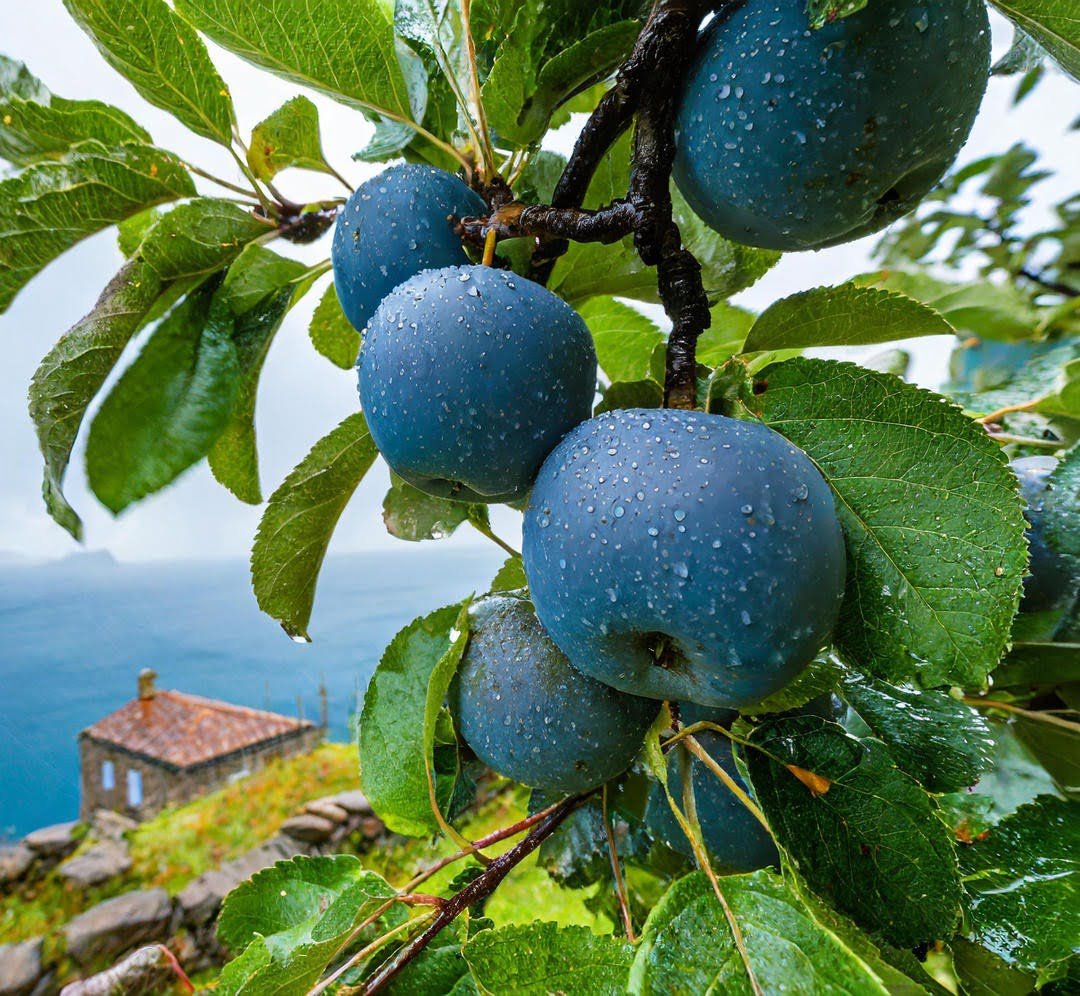
here’s a short information chart about Blue Apple:
| Attribute | Description |
|---|---|
| Scientific Name | Malus domestica |
| Common Name | Apple |
| Family | Rosaceae |
| Origin | Central Asia, specifically in present-day Kazakhstan |
| Description | Deciduous tree with round, pomaceous fruit |
| Cultivars | Thousands of cultivars exist worldwide |
| Varieties | Includes sweet, tart, and dual-purpose varieties |
| Nutritional Value | Rich in fiber, vitamin C, and various antioxidants |
| Culinary Uses | Eaten fresh, used in cooking, juicing, and baking |
| Economic Importance | One of the most cultivated and consumed fruits globally |
| Symbolism | Often symbolizes health, temptation, and knowledge |
Blue apples are a result of natural anthocyanin pigments, which are responsible for the blue, purple, or red colors found in various fruits and vegetables. These pigments develop in the apple’s skin as it grows and ripens, giving it the striking blue hue. Blue apples can display varying shades of blue, ranging from deep indigo to vibrant turquoise.
Anthocyanins, the pigments responsible for the blue color in blue apples, are not only visually appealing but also offer health benefits. Studies have shown that these pigments possess antioxidant properties, which help protect the body against harmful free radicals. Additionally, anthocyanins have been linked to improved cardiovascular health and reduced risk of chronic diseases.
Blue apples are not just a feast for the eyes; they are also a nutritional powerhouse. Like other apple varieties, blue apples are a good source of dietary fiber, vitamin C, and various minerals. The blue hue in their skin is an indication of their high antioxidant content, making them an excellent choice for those looking to boost their overall health.
The Unique Appeal of Blue Apples
Beyond their mesmerizing appearance, blue apples possess a delightful taste that sets them apart from traditional apple varieties. Their flesh is crisp, juicy, and slightly tart, offering a refreshing and unique flavor profile. The combination of their remarkable color and delicious taste makes blue apples a coveted addition to fruit bowls, baked goods, and culinary creations.
Blue apples can be enjoyed in various ways. Their vibrant color adds a pop of visual interest to fruit salads and desserts, while their tangy flavor complements savory dishes like salads and roasted meats. Blue apple pies and tarts are also popular choices, allowing the natural sweetness of the fruit to shine through.
When it comes to selecting blue apples, it’s important to choose ones that are firm, with smooth and unblemished skin. The intensity of the blue color can vary between different varieties, so it’s worth exploring different options to find the shade that appeals to you the most.
Whether you’re a fan of unique flavors, a health-conscious individual, or simply someone who appreciates the beauty of nature, blue apples offer a one-of-a-kind experience. Their striking appearance, combined with their delicious taste and potential health benefits, make them a fascinating addition to the world of apples.
Detailed Overview of the Best Blue Apple Varieties
When it comes to apple varieties, there is a wide range of options to choose from. However, if you’re looking for something truly unique and visually stunning, blue apples are the way to go. In this detailed overview, we will explore the top six blue apple varieties that are sure to impress both your taste buds and your eyes.
1. Blue Pearmain Apple
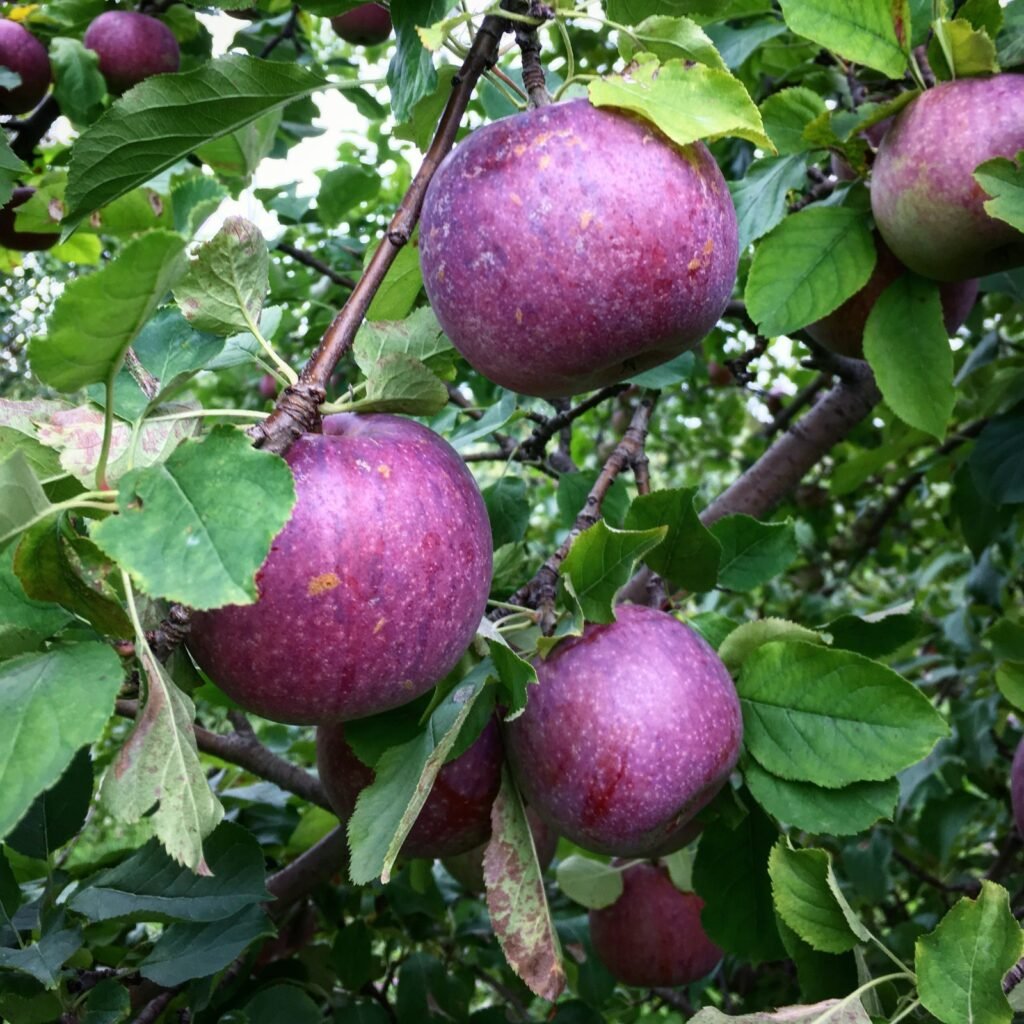
here’s a short information chart about the Blue Pearmain Apple:
| Attribute | Description |
|---|---|
| Name | Blue Pearmain Apple |
| Origin | United States, likely New England |
| Appearance | Medium to large size, round with blue-purple |
| skin, often covered with grayish bloom | |
| Flesh | Creamy white, sometimes with pinkish hues |
| Taste | Sweet-tart flavor with hints of spice and |
| floral notes | |
| Texture | Firm and crisp |
| Harvest Season | Late September to October |
| Uses | Fresh eating, baking, cider making |
| Storage | Stores well, maintaining flavor and texture |
| for several months | |
| Tree Characteristics | Vigorous growth, requires well-drained soil |
| and full sun |
The Blue Pearmain apple is a standout variety among blue apples. With its sweet and tangy flavor, it offers a delightful taste experience. But it’s not just the flavor that sets this apple apart. Its firm and creamy white flesh adds a pleasant texture to every bite. This heirloom variety boasts a rich history and is widely cherished by apple enthusiasts.
Legend has it that the Blue Pearmain apple was first discovered in the early 19th century in New England. Since then, it has gained popularity for its unique flavor and beautiful blue skin. Whether enjoyed fresh or used in baking, this apple is sure to leave a lasting impression.
2. Blue Moon Apple
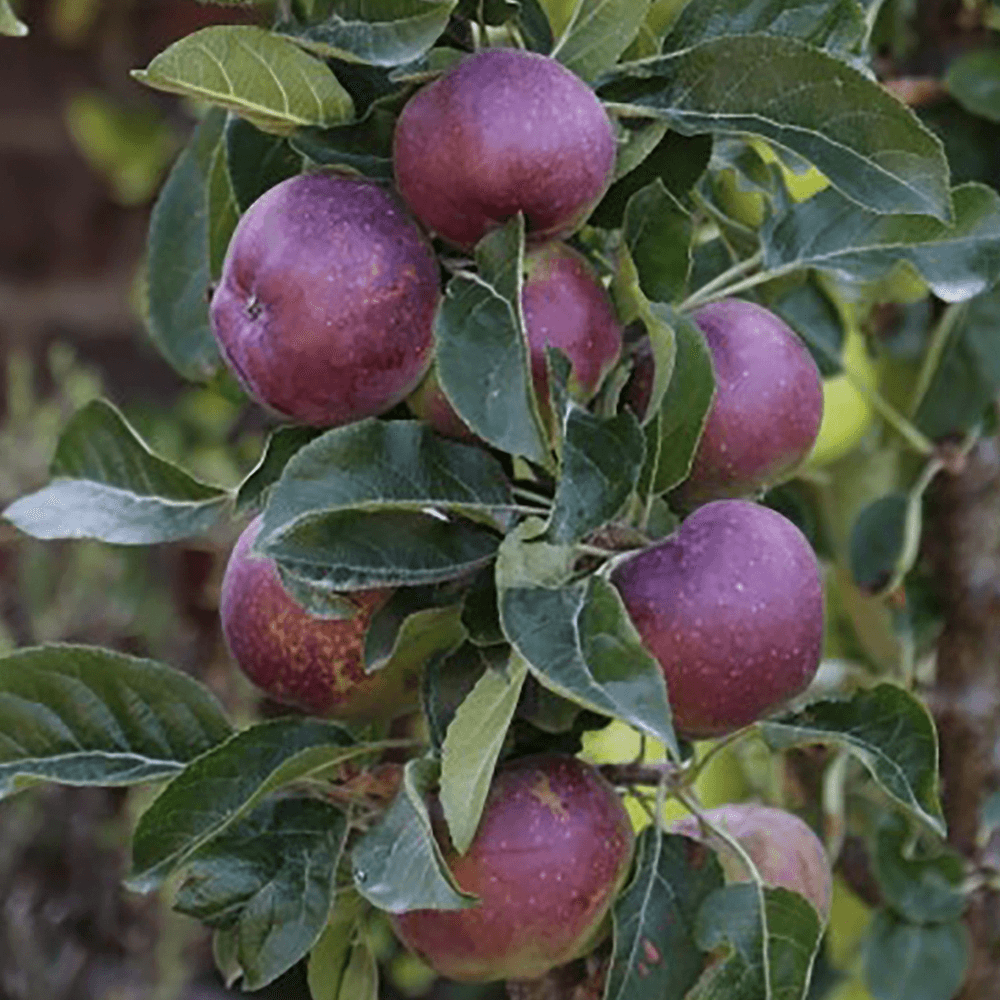
Here’s a short information chart about it:
| Attribute | Description |
|---|---|
| Name | Blue Moon Apple |
| Origin | United States (developed by Cornell University) |
| Appearance | Medium to large size, round to slightly oblong, |
| blue-purple skin with specks of white | |
| Flesh | Creamy white |
| Taste | Sweet and mildly tart, with hints of vanilla |
| Texture | Crisp and juicy |
| Harvest Season | Typically harvested in late September to early |
| October | |
| Uses | Primarily eaten fresh, can also be used in |
| salads and desserts | |
| Storage | Stores well, maintaining flavor and texture |
| for several weeks after harvest | |
| Tree Characteristics | Adaptable to various climates and soil types |
With its enchanting name, the Blue Moon apple lives up to its reputation by delivering a unique combination of flavors. This variety offers a perfect balance between sweet and tart, with a hint of floral notes. Its crisp texture and captivating blue color make it a standout choice for various culinary applications.
Imagine taking a bite of a Blue Moon apple and being transported to a moonlit orchard, surrounded by the sweet scent of blooming flowers. This apple is not just a treat for the taste buds but also a feast for the imagination.
3. Blue Diamond Apple
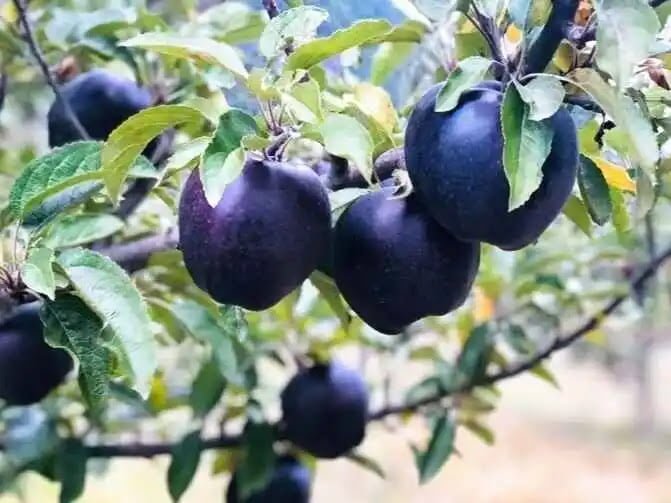
Here’s a short information chart about it:
| Attribute | Description |
|---|---|
| Name | Black Diamond Apple |
| Scientific Name | Malus domestica ‘Black Diamond’ |
| Origin | United States |
| Appearance | Medium to large size, round, dark purple to |
| nearly black skin | |
| Flesh | Creamy white |
| Taste | Sweet, with a subtle tartness and hints of |
| berry-like flavor | |
| Texture | Firm and crisp |
| Harvest Season | Typically harvested in late September to early |
| October | |
| Uses | Primarily eaten fresh, can also be used in |
| salads and desserts | |
| Storage | Stores well, maintaining flavor and texture |
| for several weeks after harvest | |
| Tree Characteristics | Adaptable to various climates and soil types |
As the final blue apple variety on our list, the Blue Diamond apple is a true gem. Its deep blue skin conceals a creamy white flesh that offers a perfect balance of sweetness and tartness. This versatile variety is ideal for snacking, cooking, and using in desserts.
When you bite into a Blue Diamond apple, you’ll discover a hidden treasure. Its crisp texture and refreshing flavor make it a popular choice among apple enthusiasts. Whether you’re enjoying it on a sunny afternoon or using it to create a delectable apple-based dessert, this apple is sure to shine bright like a diamond.
So there you have it, a detailed overview of the six best blue apple varieties. Each variety offers its own unique flavor profile, texture, and visual appeal. Whether you’re a fan of sweet and tangy apples or prefer a more balanced flavor, there is a blue apple out there to suit your taste. So why not add a splash of color to your fruit bowl or recipe collection with these extraordinary blue apples?
Essential Facts about Blue Apple Varieties
Nutritional Value of Blue Apples
Blue apples not only add a pop of color to your plate but also provide numerous health benefits. They contain essential vitamins, minerals, and antioxidants that help support a healthy lifestyle. Blue apples are a good source of vitamin C, fiber, and potassium, which contribute to overall well-being.
Health Benefits of Blue Apples
In addition to their nutritional value, blue apples offer a range of health benefits. The presence of anthocyanin pigments in blue apples provides powerful antioxidant properties, which help protect cells from damage caused by harmful free radicals. Blue apples also promote heart health, aid digestion, and support a strong immune system.
Growing Blue Apple Varieties
Ideal Climate for Blue Apple Trees
Growing blue apple trees requires careful attention to climate conditions. These varieties thrive in temperate regions with cold winters and mild summers. Blue apple trees prefer full sun exposure, which allows them to develop their unique blue coloration. They also require well-drained soil and benefit from proper air circulation to minimize the risk of fungal diseases.
Soil and Water Requirements
When it comes to blue apple trees, well-drained soil is crucial for their healthy growth. The soil should have a slightly acidic to neutral pH level, and periodic soil testing can help maintain appropriate conditions. Adequate irrigation is also essential, especially during dry spells, to prevent water stress and ensure optimal fruit development.
Pruning and Maintenance Tips
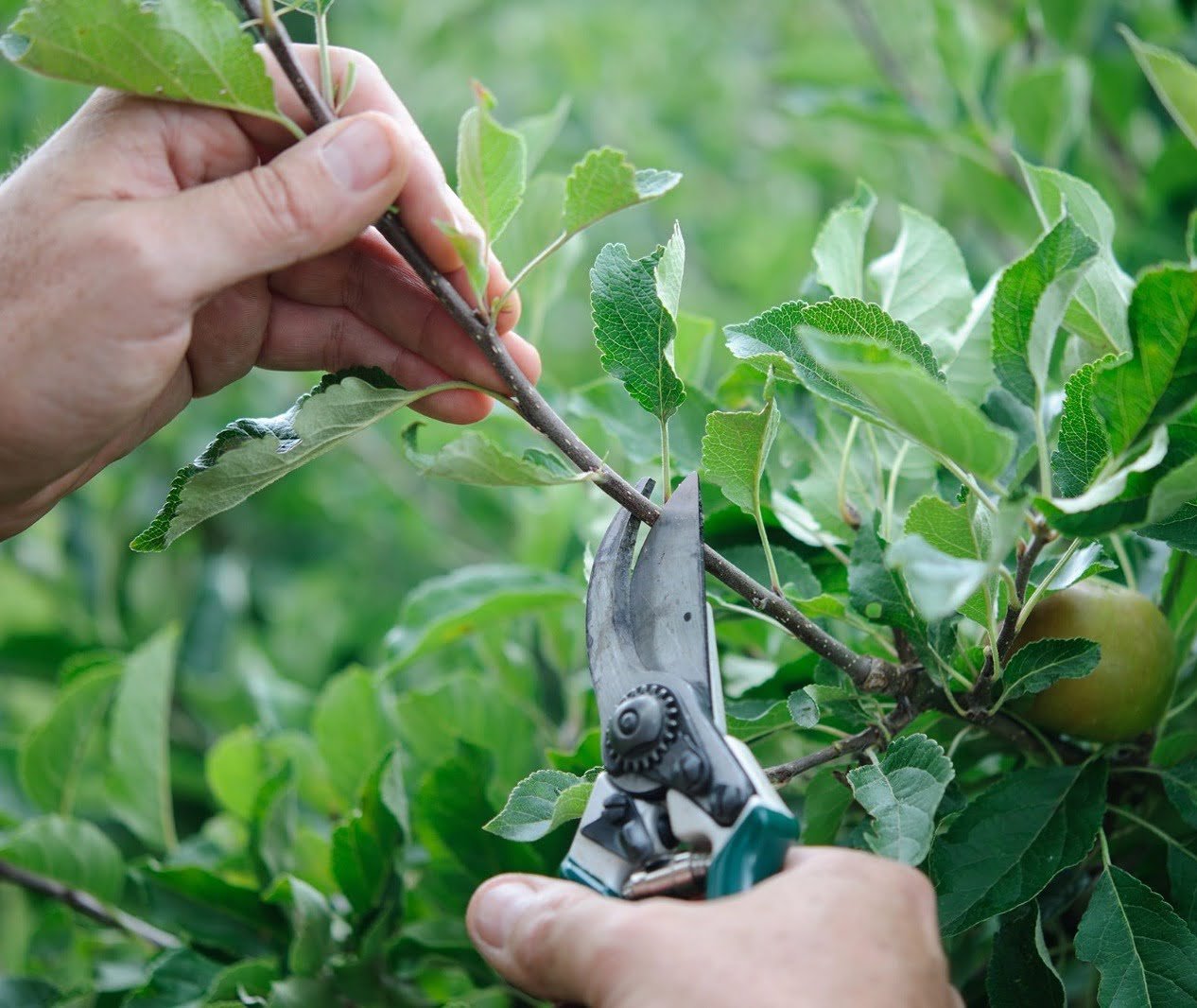
Regular pruning plays a key role in maintaining the health and productivity of blue apple trees. Pruning should be done during the dormant season to remove dead or diseased branches, improve light penetration, and encourage proper airflow. Additionally, applying organic mulch around the base of the tree can help retain soil moisture and inhibit weed growth.
Conclusion
Blue apple varieties offer a mesmerizing visual appeal, delectable flavors, and a range of health benefits. Whether you are intrigued by their striking blue color or simply looking to try something new, the six best blue apple varieties mentioned in this article are sure to captivate your taste buds. With proper care and cultivation, you can enjoy these unique fruits in your own garden. So, why not embark on a blue apple adventure and elevate your orchard with these extraordinary gems?
Pingback: Crepe Myrtle Trees & Bushes – Growing and Care
I am confused by your article. It stated that six varieties of blue apples would be listed, but only 3 were listed. There was a photo of a very blue apple, but none of the varieties listed were that shade of blue. I am interested in growing a blue apple tree, but am wondering if the bright blue apples are just a myth?
Pingback: A Complete List of Fruits That Begin with “A”
Pingback: Fruits That Start with “O”: A Complete List -
Pingback: Trees That Start with Y : Natural Beauty Explained
Pingback: A Guide to Notable Trees that Start with ‘O’
Pingback: Beautiful Trees That Start With ‘Z’ - Gardener's School
Pingback: Explore 17 Amazing Trees Starting with the Letter A - Gardener's School
Pingback: How to Grow and Care for Pink Quince : A Complete Guide